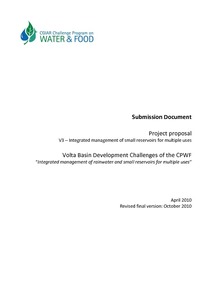Resource information
V3 project focuses on integrated management options at local scale for small reservoirs (SR), in a multiple use context. Integrated management of SR can aim at several objectives: (i) perpetuating infrastructures, obvious condition for socio-agro-ecosystem durability; (ii) protecting and if necessary improving the water quality for the various uses; (iii) reaching and enhancing water productivity potentials; (iv) seeking for equity (pro-poor position). These goals have to be compared and discussed with stakeholders’ perceptions and expectations: participative diagnosis and modeling will constitute a methodological baseline. For local management of SR, the sustainable enhancement of water productivity will require (i) to assess the different aspects of water productivity (present and its past evolution), and (ii) to test options for sustainable improvements. Assessment and test will be made with the stakeholders adopting two main ways: (1) through participative modeling of the SR functioning for testing possible evolutions, and (2) through implementing pilot operations to test some options in field conditions. Geographical analyses focusing on both diachronic (temporal evolution) and synchronic (spatial diversity) processes are thus required and will also constitute a baseline in our methodology. Developing descriptive and prospective models requires knowledge on processes and data. Quantification of local biophysical and socio-economical processes and their interactions will be addressed through combined approaches (field analyzes, experimental approaches, participative diagnosis and modeling, simulation games, etc.) Fluxes (of water, of matter, of chemicals, etc.), exchanges (of crops, of money, of information, etc.) and mobility (of people, of opportunities, etc.) will thus be specifically targeted. The externality of these flows may constitute a linchpin for further up- and out-scaling, as should be developed by V1, V2 and V4 projects. All these studies will be carried out in targeted illustrative pilot-sites located in Burkina Faso and in Ghana, and belonging to contrasted areas of the Volta Basin.


